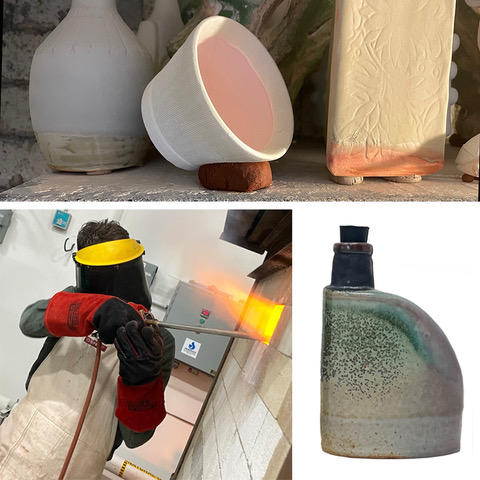Semester:
Offered:
 WAITLISTED
WAITLISTED
Begins Wednesday, February 28, 2024 - check full schedule below
Registration for this workshop is limited to those who are registered for a Spring 2024 course at the Ceramics Program, Office to the Arts at Harvard. Registration will open on February 6.
Level: Advanced
Looking for some different results from the soda kiln? We’re going to mix things up with this firing by experimenting with the kiln atmosphere, creative wadding, loading and down firing the kiln to control the cooling stage. The goal is to create more dramatic glaze surfaces and atmospheric effects. This firing is not for the faint of heart and there are no guarantees, but big risks often yield big rewards. We will invite the chaos and embrace it in this workshop. Sign the disclaimer and sign up for this workshop if you’ve got the strength.
Students in this hands-on workshop will attend a soda firing orientation and agree to the firing strategy. Session two is a discussion of glazes and flashing slips. Students will also sign up to load the kiln and work the firing which includes spraying soda and the reduction cooling stage. Unloading, a post-firing review and cleanup wraps up this workshop.
Orientation:
Wednesday, February 28, 2:00pm - 3:00pm
Glazes, Slips, and Wadding demo:
Friday, March 1, 4:00pm - 5:00pm
Loading:
Monday, April 1, 10:00am - 1:00pm
Tuesday, April 2, 1:00 pm - 4:00pm
Firing:
Wednesday, April 3, 5:30am - 5:00pm (spray @3:30 – 4:00 pm)
Unload, Cleanup, and Critique Work:
Friday, April 5, 12:00pm - 3:00pm
WHAT MAKES SODA FIRING SO DIFFERENT?
Soda firing is similar to the cone 10 reduction firing, but with these differences.
- The outside of the piece does not need to be glazed since the soda affect will create a finished surface without glazing.
- The soda ash will create more melting with a glaze on the outside surface, which will make some glazes more fluid causing them to run if the glaze is applied too thick.
- Not all high fire reduction glazes are suitable for soda firing.
- Since the bottoms of pieces fired in the soda kiln are wadded with a mixture of clay and alumina hydrate, more space needs to be left between the lower edge of the outside glazed area and the bottom of the piece.
- It’s a requirement to participate in either the loading or unloading and cleanup of the soda kiln if work is fired in the soda kiln.
Registration for this workshop is limited to those who are registered for a Spring 2024 course at the Ceramics Program, Office to the Arts at Harvard. Cost: $100. Free for Harvard Undergrads.